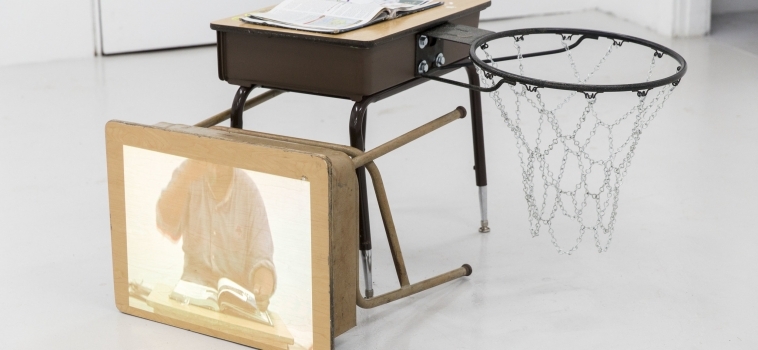Standing Together
By Hailey Stangebye
Photos & videos courtesy of Cameron Granger
Cameron Granger didn’t expect to find a community in Columbus.
When he came from Cleveland to study at the Columbus College of Art and Design, he knew he wanted to major in the cinematic arts. But he didn’t know just how much he would learn outside of the classroom from his network and mentors.
“I don’t think I realized it at first, but I’m a very community-oriented person. I thrive in close knit communities,” Cameron says. “When I first came to Columbus, Maroon Arts — Marshall Shorts, David Butler and them — they were the first people to ever embrace me and see value in what I was doing. I had a really hard time when I first got here, and they took me under their wing and assured me that this was for me.”
“I don’t think I realized it at first, but I’m a very community-oriented person. I thrive in close knit communities. When I first came to Columbus, Maroon Arts — Marshall Shorts, David Butler and them — they were the first people to ever embrace me and see value in what I was doing. I had a really hard time when I first got here, and they took me under their wing and assured me that this was for me.“
He Say She Say from Cameron Granger on Vimeo.
Without such a support system, Cameron says he probably would have left Columbus a long time ago. Now he’s learned to thrive in this arts community, but that journey wasn’t easy.
“Art is a primarily white field. Film is a primarily white field,” Cameron says. “I think, for a long time, it was hard for people to take what I was doing seriously. I would show certain things and there wouldn’t be a discussion around it. It seemed like people were afraid to or didn’t know how to engage with what I was making. It was really disheartening.”
“Art is a primarily white field. Film is a primarily white field. I think, for a long time, it was hard for people to take what I was doing seriously. I would show certain things and there wouldn’t be a discussion around it. It seemed like people were afraid to or didn’t know how to engage with what I was making. It was really disheartening.“
That realization was all the more disheartening because Cameron uses his works to tell a story and to generate dialogue. He first discovered that he could speak through video in high school.
FIRE!! – Teaser Trailer from Cameron Granger on Vimeo.
Prior to creating films, Cameron followed in the footsteps of his mother and grandmother by writing and drawing. Then he took a class that changed the trajectory of his life.
“Everything I was struggling to say through writing and drawing, I was able to say really easily through video,” Cameron says. “It was this perfect merging of the two.”
“Everything I was struggling to say through writing and drawing, I was able to say really easily through video. It was this perfect merging of the two.“
Initially, Cameron focused his energy on traditional film projects. That changed when he joined the MINT Collective, a local artist collective. Those friends and peers encouraged him to create installation and studio-based films.
“My work is an exploration into the media that I watched growing up — various representations of black men in movies, music, tv shows. I see what impact they had on me, and then everyone around me,” Cameron says. “I’m using the micro of myself to speak to the larger macro of a whole.”
Invisible Man from Cameron Granger on Vimeo.
Cameron says that he often feels pressured to create specific types of work because of the color of skin.
“When people see black folks making art, there’s a tendency to slap hot button topics like police brutality or other things to it, and I’m not interested in doing that right now,” Cameron says. “I’ve made things like that before and I think those are very important to exist, but I’m not really interested in talking about them right now.”
“When people see black folks making art, there’s a tendency to slap hot button topics like police brutality or other things to it, and I’m not interested in doing that right now. I’ve made things like that before and I think those are very important to exist, but I’m not really interested in talking about them right now.“
One of his latest projects is a mural in the Short North, which is a still from his film called “Urn, Or Another Way To Say I Love You.” The film is about the space between “you” and the thing you “love.”
“The more things you do to shorten the space or gap between ‘you’ and the thing you ‘love,’ the more you become what you’re trying to protect that love from,” Cameron says. That idea is particularly relevant for black artists showing work in the Short North.

“The love that I, and perhaps other black artists, have for these experiences that we’re talking about in our work, we want to cherish that; but we also want to share that,” Cameron says. “That’s the commodification of this love. In putting this work up on the wall in a part of town that is primarily white, we wonder how that’s going to be taken. And now that it’s all up in the wild, what do you do about that?”
Cameron has clear goals for the function of these murals.
“I just want to keep the momentum going,” Cameron says. “I don’t want the images that are up to be just backdrops for selfies. I want to think more about how to activate them. I think I was resting on my laurels a bit in regards to Columbus and seeing this has re-energized me to do more here.”
“I just want to keep the momentum going. I don’t want the images that are up to be just backdrops for selfies. I want to think more about how to activate them. I think I was resting on my laurels a bit in regards to Columbus and seeing this has re-energized me to do more here.“






